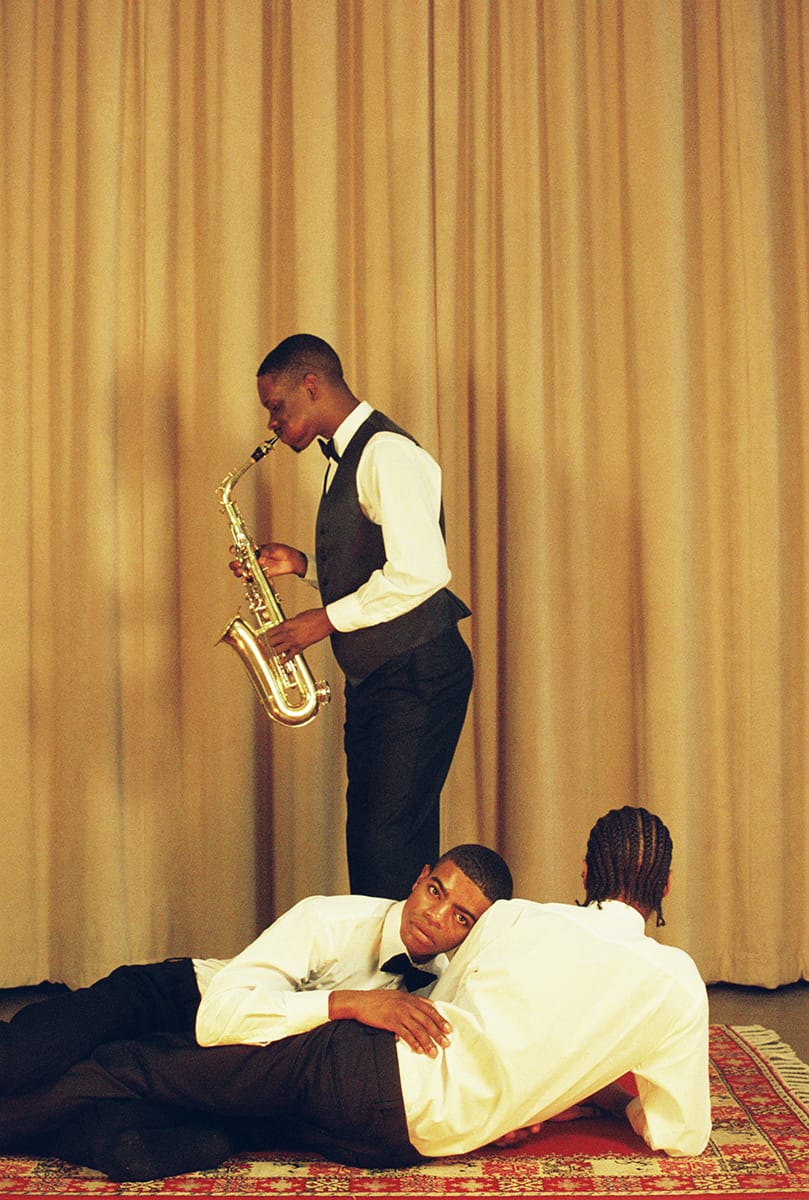Interview 088 • Feb 18th 2024
- Interview by Asa Featherstone IV, Self-Portrait by Clifford Prince King
About Clifford Prince King
Clifford Prince King is an artist living and working in New York and Los Angeles. King documents his intimate relationships in traditional, everyday settings that speak of his experiences as a queer black man. In these instances, communion begins to morph into an offering of memory; it is how he honors and celebrates the reality of layered personhood. Within King's images are nods to the beyond. Shared offerings to the past manifest in codes hidden in plain sight, known only to those who sit within a shared place of knowledge.
Links
Foreword
I was introduced to Clifford’s work in a group exhibition titled “Love Songs” at the International Center for Photography (ICP). There was an image of two boys embracing privately in a field. I felt a strong sense of relief in that photo, almost like they had been waiting all week for that single moment. His portrayal of relationships, tenderness, and care between men felt unique and made me want to ask for a conversation.
After recently moving from Los Angeles to New York City, his work is evolving from a private experience to something more involved. His project, “Acts of Service” seems to signal that turning point, where he creates fantasies based on a world where care and desire are normalized. Along with sharing the process behind that project, he emphasizes the importance of privacy, safety, and romance when telling queer stories, keeping things simple, and how living with HIV impacts his life and creative practice.
----
This interview has been edited for clarity and content.
Interview
I don’t know how much you push this, but I listened to the SoundCloud mixes that you put together and linked on your site. Those are so good.
Haha. Yeah. They kind of all started during the pandemic. Music has always been healing to me.
I didn’t get through all of them, but it was cool listening to it as I was looking through your work. How much does music play a role in your creative process?
I don’t know, that’s a good question. I’ve never been asked that before. I think I just like listening to things that generate feelings. Lately, I’ve really been enjoying music with less information, meaning without vocals or speech. Like the new Andre 3000 is pretty incredible. In the mornings, putting that on and being silent with music has been really nice. It makes me feel warm.
Do you listen to music at all while you’re photographing?
Yeah, I’ll put some jazz on or something. I’m really into Robert Glasper. If not jazz, then maybe some drum and bass. I try to make my space feel really welcoming when I’m photographing people. I don’t just dive into taking photos as soon as someone comes over. I’ll always start out with some tea or coffee, just have some downtime, and feel out what I want to execute within the frame. And I like to see how the natural light changes throughout the time we spend together. I like to keep my process free and less structured to allow room for creativity to step in.
You made that sound so lovely.
Yeah, sometimes things can come off as artificial if they’re super structured with mood boards and everything. I understand the need to be organized, especially for large-scale projects, but sometimes I feel like it limits the actual freedom and nuance in the work.
Right. Looking at your work, it’s clear that you’re documenting a queer, Black experience. There are elements of your work that are physical, and strong, but gentle. And, respectfully, I want to say you’re exploring masculinity, too. Am I grasping the right adjectives? How would you describe your work?
Yeah, that’s pretty close. A lot of people say it’s intimate, and I feel like we can retire that word a little bit. Haha. I would describe my work as film stills of an experience that has happened. Either in my life or an experience that I’ve daydreamed about that I would want to bring into reality visually. A big thing for me is romance. I feel like I’m a pretty, dreamy, romantic person.
When you say romance, what do you mean?
I feel like it’s a display of desire. It’s that feeling you get when you’re out and see something cute happening between a couple that you wish you had. It’s almost like seeing something precious happening, and as a photographer, you want to capture it, but usually, it passes by too quickly, so I try to recreate those kinds of moments but make them Black and queer.
I get a lot of my inspiration from people-watching, especially in LA and New York. There are all these little scenes that I see popping up that are simple, but magical. I try to take snapshots of a grander story, whether it’s true or false, and bring it into a Black queer narrative, normalizing our everyday experience. I try to imagine what that future could look like.
Lately, I’ve been thinking about shifting more toward outdoor narratives, where my earlier work has been focused on interiors and creating this world within a private, safe space. Queer love and intimacy in my work prioritized privacy, which was means of safety, or having the freedom to be as expressive as one might want to be. The images I want to make outside are very much a direct reflection of what I want to see in the world. Without there being questions about whether what you see is right or wrong, it just is.
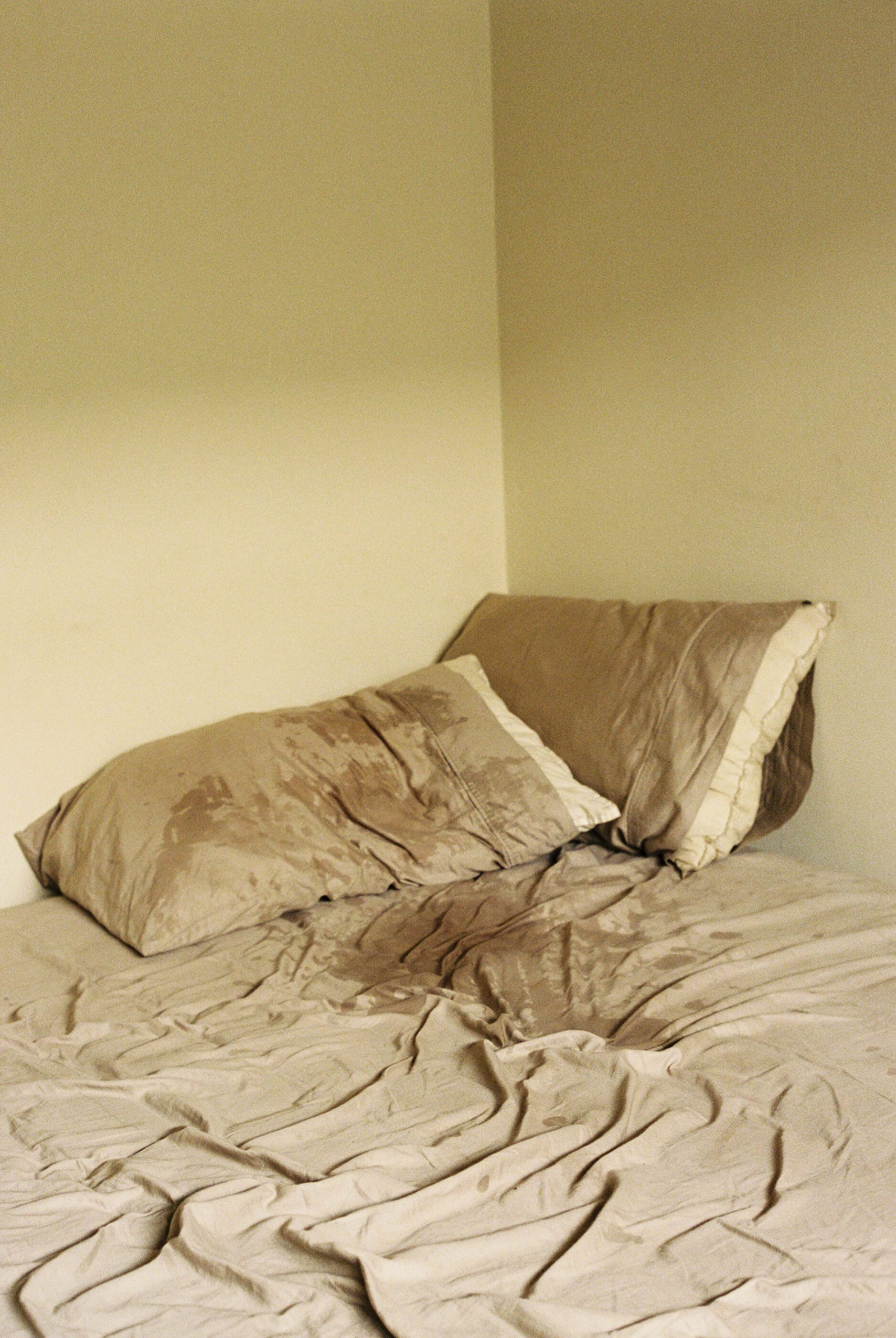
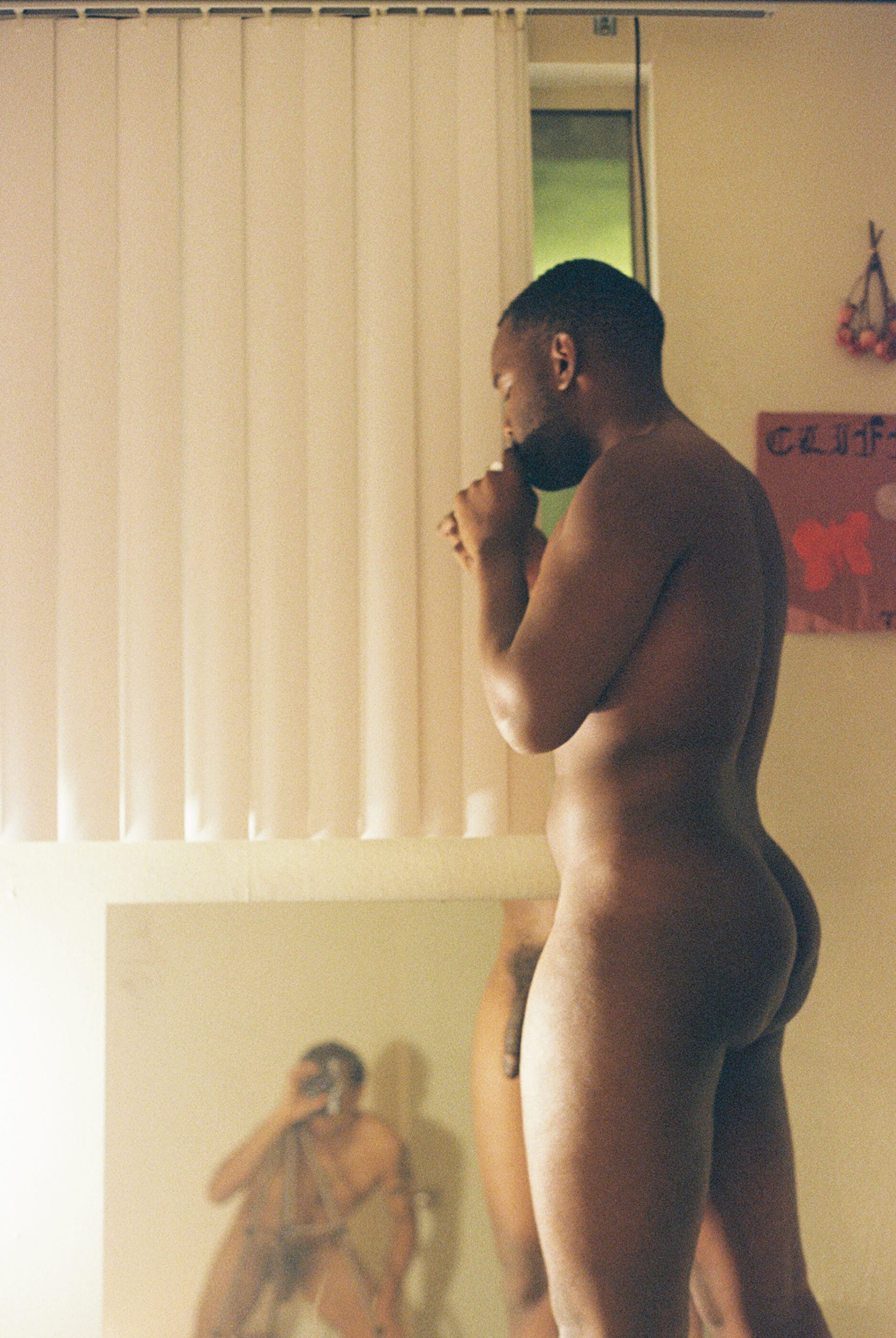
Mmm. A lot of your photos are taken inside bedrooms and homes. So, that’s mainly for safety? Is it also out of respect for your subjects?
Mainly, yes. If I’m shooting outdoors, people like to stop and look which puts a lot of pressure on the people I’m photographing, especially if they aren’t models. I think when you’re inside, you’re disarmed and relaxed. Even the way someone is standing, breathing, or sitting changes.
I also have to be mindful of photography politics. I feel like I have a responsibility to protect people and do right by them. How I capture my portraits helps too. If you notice, a lot of the faces in that work are partially covered. It’s kind of mysterious and makes the portrait universal. The point isn’t to find out who the person is in the photo, I want to make work that generally everyone can relate to in some way.
Yeah! It’s something that feels familiar even though we don’t know who the people are in the frame. How do you gain the trust of your subjects and get them to be comfortable with you? Some of your subjects are in vulnerable situations.
Well, most of them are friends which makes things a lot easier. But, in the beginning, a lot of those works were mainly taken after having a sexual encounter, or when I’m already hanging out with people in my space, and I’ll just pull my camera out after a while. But I know that also seems crazy. Haha. Some of the images where the face isn’t visible are people who I’ve gone on dates with or met on dating apps.
I see. When you were dating these folks, did you know at the end of the encounter that you were going to come away with a photo?
I didn’t, and I think that’s what makes it so interesting. I didn’t see the images going anywhere, they were always meant to be for me, as memories. But as these images came together, I think they started to say something that related to people. The full series of this work is about the range of relationships we have—platonic friendships, sexual friendships, and romantic relationships— how they differ, but also how they overlap.
And coming back to gaining trust, I’m always thinking about the camera and permission, it’s different depending on the person. When people come over, I’m responding to that person’s energy rather than coming in with an idea of what I thought was going to happen.
Like, sometimes a friend will come over and we know we’re going to end up taking photos. We’ll have a glass of wine, eat dinner, and take photos after. In other instances, I’ll invite someone I met on Grindr or something like that, and I’ll see them do something as they’re getting dressed or drinking the water that I got for them and notice that the way they do it is so unique, so I ask them to hold the pose and take a picture. During the time I was making that work, sharing space with other Black queer people was unfamiliar, so when I was in those spaces, it felt like I was witnessing something very beautiful for the first time. We both are. The two of us are sharing a space, stripped of the world.
There have been people who don’t want a photo taken, and I respect that. It’s all about responding to the individual, which makes it fun. But I can’t navigate it the same way I did before. I feel like it would get too messy.
Is that because your work is more public now?
Yeah. Especially now that I do know where these could end up. I’m showing in more recognizable spaces now. These photos are still just for me like they’ve always been, but there may come a point where they grow beyond that.
I get that. Sometimes intention isn’t always enough. When did you feel empowered to tell these stories this way? I imagine the vision wasn’t always this clear.
Right, it wasn’t. I don’t really know how that happened. I think over time, it just felt like I was creating a diary. I would document what my room looked like, the people around me who were open to being photographed, or people I was going on dates or spending nights with.
Over time it became a visual representation of my identity and a form of healing. A lot of the work you’re referencing was made in my early 20s and, not to put age on it, but I think your early 20s are a lot about exploring your sexuality. I was figuring that out as I was making work.
It was an interesting place to be in because I grew up thinking that queerness, being around other Black queer men and being affectionate wasn’t a thing. You don’t really see that being portrayed in media, so I think over time I wanted to create that reality. But once I started seeing what it was like in Los Angeles, I felt more seen. That moment was really important for me. So, when I make my work, or share it on the internet, I hope I can create that moment for other people too.
I’m sure that move was huge. I know you just moved from LA to New York, but you’re originally from Arizona, right? What was your favorite and least favorite thing about growing up there?
Hmm. My favorite thing is the monsoon season. I think it happens around late summer and it’s always thunderstorming. The sky has so many purples, blues, and reds, and there’s lightning everywhere. We have something called a creosote bush that smells amazing when it gets wet from the rain.
I guess my least favorite part would be that, outside of Tucson or any of the major cities, it can be a little more traditional if you know what I’m getting at. It was a red state when I was living there and I wasn’t always the most comfortable, being Black and queer. I think it turned into a blue state, but, I don’t even want to get into that. I wouldn’t really call Arizona diverse. I mean, there’s a large Mexican population, but as far as Black population, it’s a little sparse. I moved away when I was 18 to Portland. The diversity wasn’t much better. Haha.
Haha, yeah wait a minute!
In their defense, Portland gave me that indie, diet San Francisco vibe that I wanted and could afford at the time.
I could see that. So, when did you start making work? When you were in Arizona?
I mean, I always had a film camera even in high school. I took a digital media course in back then where I made music videos, short films and stuff like that. I guess the work that I’m making now started during my last few years living in Portland because I was seeking a Black, queer community, and I would just reach out to people and artists whom I’d heard of, but hardly knew, and set up these times to meet and take their photograph.
This was around 2015. I was shooting on film, so a lot of these artists were happy to have photos that looked different to either promote on their website, have nice photos of themselves, or whatever they needed them for. It was a nice exchange. I did the same thing when I moved to LA: meeting other designers and artists who are connected to other people.
It’s like a ladder, you know? I’ve just been meeting people throughout the last 7 or 8 years and collaborating with them.
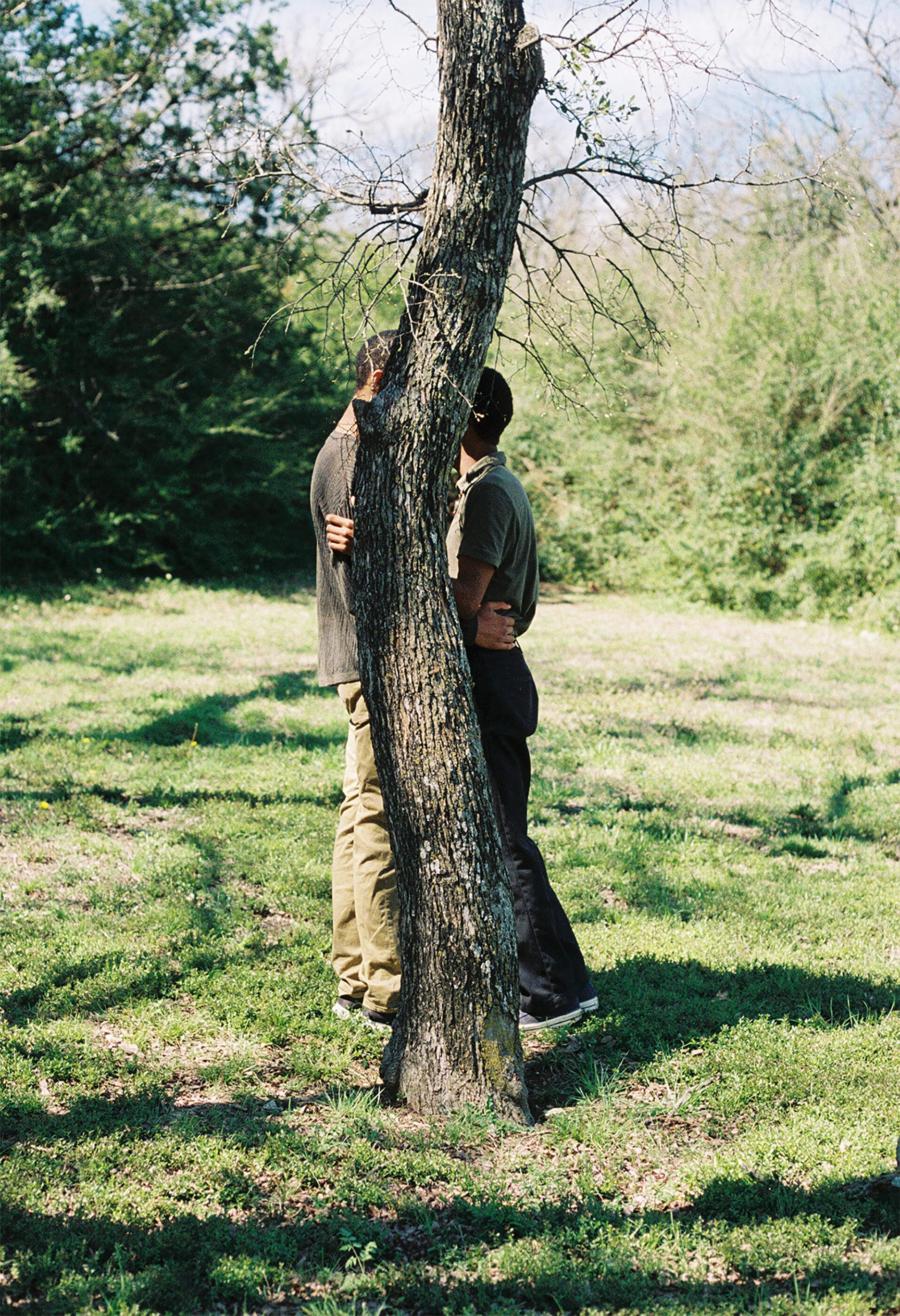
So, before you started photographing people, what were you taking pictures of? Also, what got you interested in specifically photographing the queer Black experience?
I think just having a lack thereof community. Before specifically making portraits, I would mainly take my camera and walk around and shoot something similar to street photography, but it was a little more like architectural landscapes. I would take tons of walks around the neighborhood or go to the park and chase light.
After a while, I wanted to connect with people who I found intriguing or had distinct qualities, whether it be their energy, how they looked, or how they moved in public spaces. I thought it was a nice personal challenge to be able to capture someone’s essence in the photograph.
But then, when I moved to LA, as a 24-year-old queer Black person, I feel like I was finally living in a city that could provide the dating experience that I wanted. Even outside of dating, the city had a diverse collection of people who I felt would be nice to connect with. So, I started photographing people I would meet, or hook up with in my apartment, which was very bare because I didn’t furnish the place very well. It acted as a studio for a while.
Oh, interesting.
It wasn’t anything outrageous. Just an empty apartment with popcorn ceilings and carpet, but golden hour in Los Angeles was everything. The light really came into my bedroom perfectly. I used to work at a Sprouts deli if you’re familiar with that grocery store, which was like a 20-minute walk from my apartment. I worked the early shift and would go in at 3 am, which was great because I’d get off work at noon or sooner, and still have a whole day to either shoot with someone or work a gig if one popped up. It was a nice way to have time for my practice, but also have sustainable income.
How long were you working there?
I worked there for like three years and then 2020 came around and I just couldn’t do it anymore. It was crazy, working at a grocery store during that time. Black Lives Matter was at its peak, too.
There was a lot of energy that I needed to save myself from. So, I quit. I started working more on commissions around the same time. We all know people were really trying to put on Black artists, and because of that, I was able to fully start my freelance journey.
Yeah, that’s definitely something a lot of artists capitalized on.
Right. I joke about it sometimes, but if we’re real about it, a lot of Black artists got a big boost that year! Things happened so quickly because there was so much guilt around the lack of Black photographers being represented.
Seriously! So many folks got thrust into the industry all at once. When people started bringing opportunities to your door, did you feel like you—or your work—was ready?
Yeah. I feel lucky, in a way. At the same time, it’s a weird thing to feel happy about it because you start to realize that Black death and injustice helped me reach a certain level professionally. It catapulted not only my career but the careers of a lot of image makers. Certain museums, The New York Times and Vogue were really going hard commissioning new Black photographers. Thinking back to that time, if none of that ever happened, I would still go back to Sprouts today. Haha.
My practice has very much been like medicine for myself and I’d still do it regardless of whether I’m paid or not. I feel like everything else that’s come with this has been such a big bonus versus something I really strived for, you know.
Oh, really?
Totally. And even though a lot of the work has been stacking up, I’m always shooting for me. I like to make sure I continue to honor the aspects of my practice that focus less on what these photographs can be and just bask in process and repetition. I don’t want to call it a pastime, but photography still feels like a hobby to me.
I still just enjoy seeing an image in my head and making it a reality. Whether it’s today or next week. I’m fueled by creating.
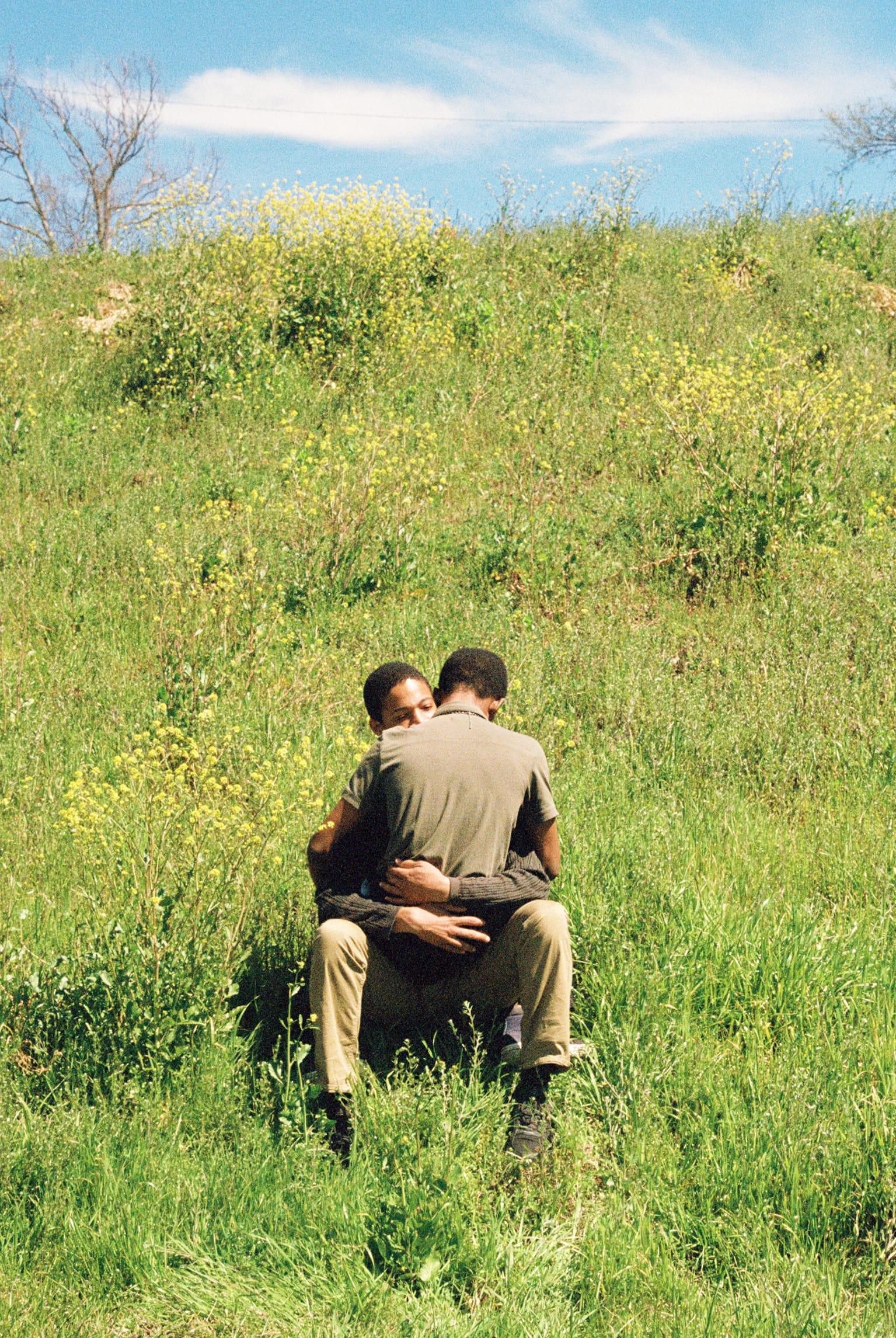
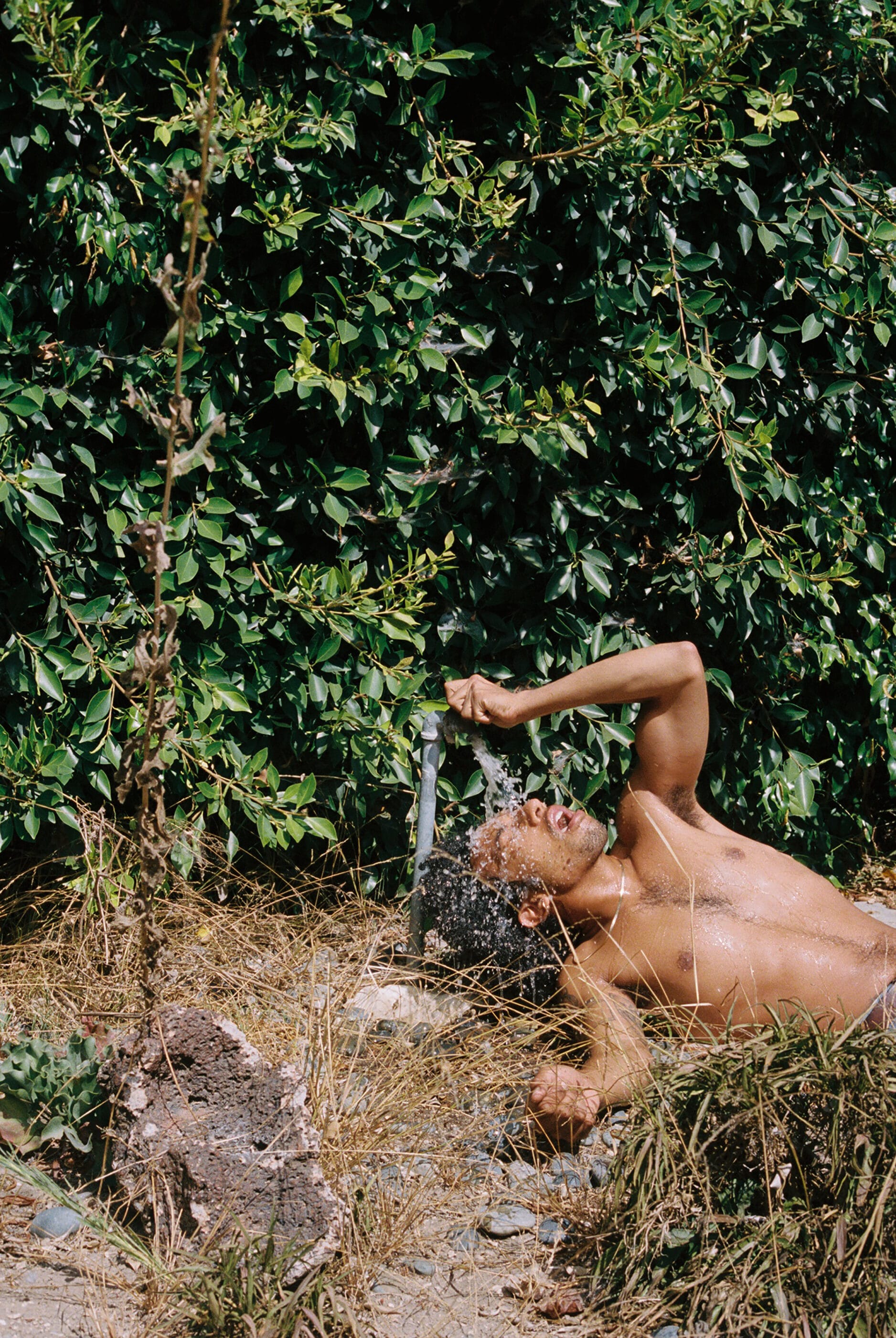
How do you make time for personal work now that you have all these commissions?
Haha! Um, it’s pretty funny, actually. I work with film so it’s easier this way, but sometimes I’ll finish a job and still have 10 or so frames left on a roll. So, I’ll come up with an idea for a quick project to finish the roll before I turn them in to get scanned, which is either that same day or the next day. That’s been a fun way to challenge myself to use those frames and to be more intentional even when I have small windows of time.
For most commissions, I try to map out the number of frames it’ll take to get the job done for the shoot, and leave a few frames for myself, if possible, that way I have something to look forward to in the end!
Ha! You finessed the system.
I like to think of it as a regrouping of the images. Haha!
I want to talk specifically about your project, Acts of Service. It’s a fascinating series that stylistically feels different than your previous work. Most of what I’ve seen outside of that project is very private, on-location, and naturally lit. Acts of Service feels more structured and calculated in the scenes you created. What was that project about?
Honestly? I have a hard time answering this question because I feel like I really didn’t think about it too much. I just really like seeing acts of service. The whole project was almost like these daydreams that I created based on things I saw in real life.
For one of the images, I got inspired when I was in New Orleans at this cafe. The servers were wearing these white shirts with bowties and I just felt like I was in like a different time period. It was so beautiful. I grew up working in restaurants, and think service is such an interesting thing to watch. I have this fantasy of two men who are servers, busing the last table as the restaurant closes, but they’re kind of mad at each other so they’re throwing things, and there’s this sexual tension built up between the two. I don’t know where that came from, but I think I just saw those two people serving in New Orleans, and wondered what their relationship was like.
I was inspired to make another image when I went to Morocco a couple of months before I started the project. They have interactions where you can get scrubbed and washed by another person. They lift your arms and everything. It’s very caring and very sweet. I don’t think we have any services like that in the States, so seeing that felt out of this world.
I don’t know where I’m going with this, but I just felt very inclined to do something with that moment I saw. Thinking about the acts of service: fine dining restaurant service, giving a haircut, reading to each other, playing music for one another… they’re all different ways to show care to one another. There was a world I wanted to create, even though I didn’t fully understand what it meant.
That makes sense. One of the images I couldn’t figure out from that series, though, was the image with a dagger and an apple. What was that one about?
Right. I don’t know. Haha! I feel like an apple represents knowledge, I kept thinking about the image of Adam and Eve when I made that one. I also feel drawn to colonial paintings, and I wanted at least one of the images in the series to look like a painting. I need to take time to dive into that work a little more now that we’re talking about it. Like I said, I really just had this huge force pushing me to make these photos when I was traveling. I know for a fact that I want to do more with the scene of the two servers.
What are you thinking?
That scene just feels like a whole movie right there. Like, what happens when they go behind the door? Are they in the alley smoking a slip, or maybe throwing a ball back and forth? There were all these places my mind went with that single moment, and I didn’t want to fight it.
That’s interesting that these concepts are coming to you after you already made the work.
Well, that’s how my brain works. I feel like it’s visual first, and then the theme or underlying message usually reveals itself later.
After I make an image, I ask myself, “Okay, where did this come from? What does it make me feel, and what made me feel this way?” If my process were flipped the other way around, then I’d be overthinking the image and probably never even take it.
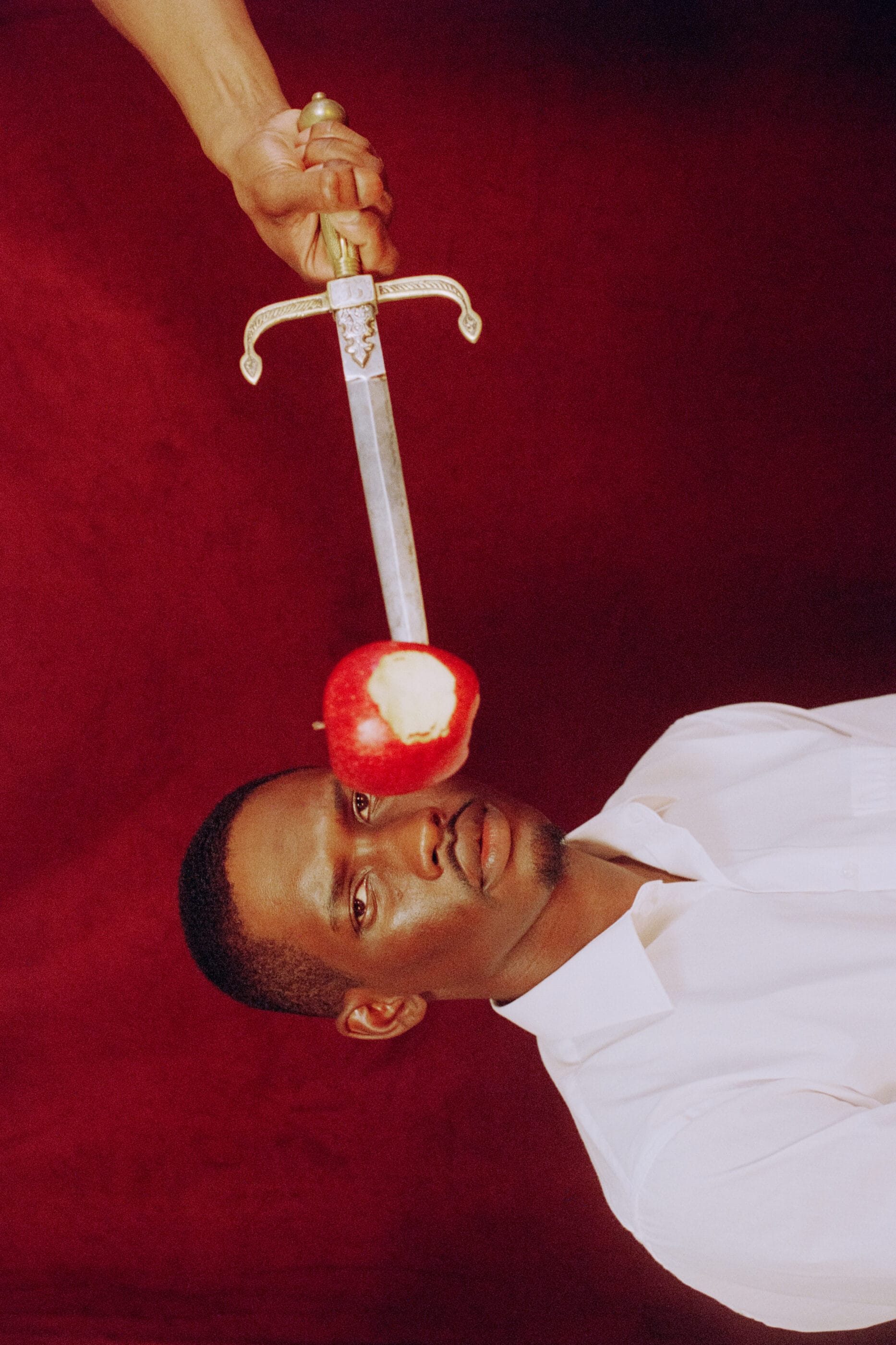

Honestly, I get that… the way that you explore romance, care, and acts of service seems so instinctual. That had to come from somewhere, right? Where did you learn to value those qualities?
Hmm. I don’t know where it stems from. That’s a good question. I think it’s just from wanting to be treated that way. But now that you asked me, I’ll have to think about that one for a while. You got me with that one. Haha.
Haha. Come back to me if you find out. You spoke to this a little bit, but do you have a preference towards the process of making the work versus seeing the result?
I think I like the process more.
Mm-hmm. I had a feeling.
Yeah, it’s fun. I think it’s been nice to be more experimental lately. Like a lot of the work isn’t incredibly sharp, but I like all the little mistakes that can come up from it, you know.
Most definitely. You mentioned your work becoming more public and now you’re getting commissioned for jobs. Is your process different for commissioned work than it is with your personal?
I try to keep it somewhat similar. Obviously, there’s a different layer of professionalism. I’m not a huge equipment person if that’s what you’re asking. I just shoot with the same camera, and I have maybe a little stand-up light if I need it. I like to rely on natural light whenever I can. Thankfully most of the people who commission me want me for my style. They’re not asking me to do something that I’m not already doing.
That’s how it should be. What are you shooting with?
I use a Canon AE 1.
Whoa. That’s like a lot of people’s first film cameras.
Yeah, it’s my first. Well, I had a Canon Rebel, but I’m not really into digital. I like the AE 1 a lot. I’ll also use my Mamiya RB 67 sometimes, but it’s a tank. It’s almost too stationary for me.
You keep it so simple. At the very least, you’re consistent.
Yes, I usually have at least one of them with me or set up at all times. But with everything, I have moments where I’m not feeling it for a few weeks, and that’s when I resort to watching movies. That’s kind of how all of this started. Cinematography is my love. Growing up in Arizona, it’s 115 degrees in the summer and you don’t leave the house until like 6 or 7. So, I was just on Tumblr and watching movies when I was in high school.
I’d stay inside too with that heat! Haha! I know you’ve dabbled in filmmaking, creating your own short films. Why did you choose photography instead of going that route?
Photography’s just a more independent medium, at least in the way that I’ve gone about it. I feel like filmmaking is such a team effort. It’s a whole production that wasn’t really accessible to me starting out. I could explore photography on my own, at my own pace. It’s just more personal to me and I really like that about it.
Yeah, your work tends to be a more private experience from what you’ve been describing.
Yeah, I also just feel like I wasn’t ready that early on. I don’t know, I feel like I have this weird thing where I don’t try to pursue things that much. It sounds bad when I say it out loud, but if there’s something that I want to do, I just sit with that idea and pray on it, or try to give myself time to think clearly about what all the possibilities would look like, versus others who really want something and immediately dive in. Sometimes it’s just timing. I wasn’t ready personally or creatively for that type of workflow. I think filmmaking is coming to me more so now than it was then, I’m just taking a different route to get there.
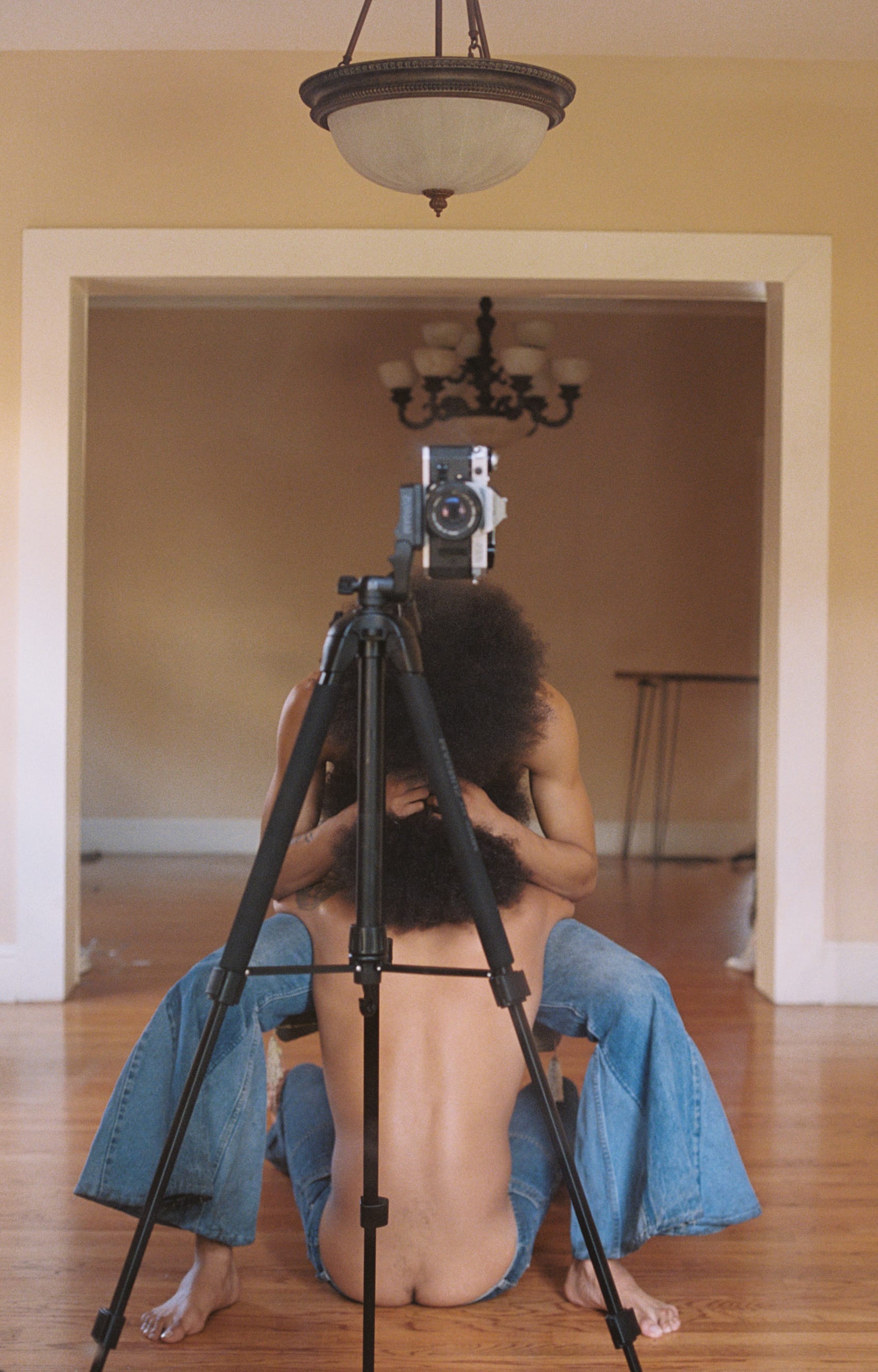
This may feel like a softball question, but why is it important to create imagery centered around Black queerness?
Why do we need this? So we can normalize different types of relationships and different forms of love. I feel like some people are more comfortable than others, but it’s going to take time for people to appreciate the nuance. I think in the past, queer visuals and representation have been pretty grotesque in the media. You know, you’re always seeing scenes in a club, and everything is hyper-sexualized or involving AIDS somehow. There’s not enough representation of the positive, romantic outlook of queer life.
I watched this movie yesterday; it was American Fiction. The way that they portrayed gays was not accurate, they only showed one type. I feel like queerness—along with most things—lives across a spectrum. Sure, you have the party days, but what does it look like to have two queer people making dinner for each other, or read to each other at a park with nice clothes on? I try to make photographs that remind me of those moments.
That spectrum of experiences is so important.
But things get even more complex when we talk about queerness and then Blackness because you can be you can be pro-Black, but anti-queer.
You know personally, navigating being Black is one thing, being queer on top of that almost adds this other layer of oppression. You even feel it from people in your own community or family. It’s almost like all odds against you, but once you’re able to normalize interactions with the people around you, there’s this sweetness and enjoyment that begins to form.
That’s a good point. Have you experienced something like that? Where you’re around folks who are pro-Black, whether it’s a professional or a personal situation, but anti-queer?
Well, I think it’s going back to the fact that people generally are afraid of what they don’t know anything about, and thinking about how big of a role religion plays in Black communities… It’s a lot.
It’s tough trying to find the time to help others understand in a way that’s not disrespectful to families or the people who do love us. At the end of the day, you have to look out for your safety. That’s why I want to make things that feel more familiar and not so heavy because these topics can drain you. I feel better about where we are than I did in the past. I have some gay cousins who live in the South, too. They’re fighting battles I can’t even imagine.
So, I think just finding your chosen family is one way to feel safe, but you also have to prevent yourself from taking on the responsibility of teaching everyone how to love and support you.
Where’s that line, though? I imagine there are people in your community who look to you—the artist and potentially the closest person they know connected to Black queerness—as an expert. You didn’t sign up for this position, this is just who you are, and this is the work that you want to make. Where do you draw the line and free yourself from additional labor?
I’ve never been good with words, which is also why images are so important to me. You know, I always think it’s nice for people to just be still and sit with what they see in front of them. Digest it over time. Everyone picks up something different. No one has the same thoughts about something they might see, and we all learn at our own pace. I’m not anyone’s teacher.
Is that why a lot of your work is short on descriptions? Whether you’re posting something or have work in a gallery… I’ve noticed that you’re not the most generous when describing what the work is about. Haha.
Haha. Yeah, it is, but also I try to be really honest with what my intentions are. I feel like some artists can really go off about the nuances and the parallels between Colonial fill-in-the-blank, which is valid, but as someone who didn’t go to school and get their MFA, I think the art of living and being in the world as a person is just as valid. It’s important to recognize the ability to make work that matters without needing to be overly academic with your language. I think it allows people to see validation in their own creations.
With my work, people can feel how they want to feel about it. I know what I wanted to say and feel when I made it and that’s what matters.
Totally. It seems like there’s a criteria that you have to meet in order to be able to have the clearance to say what’s on your mind and be taken seriously.
Right.
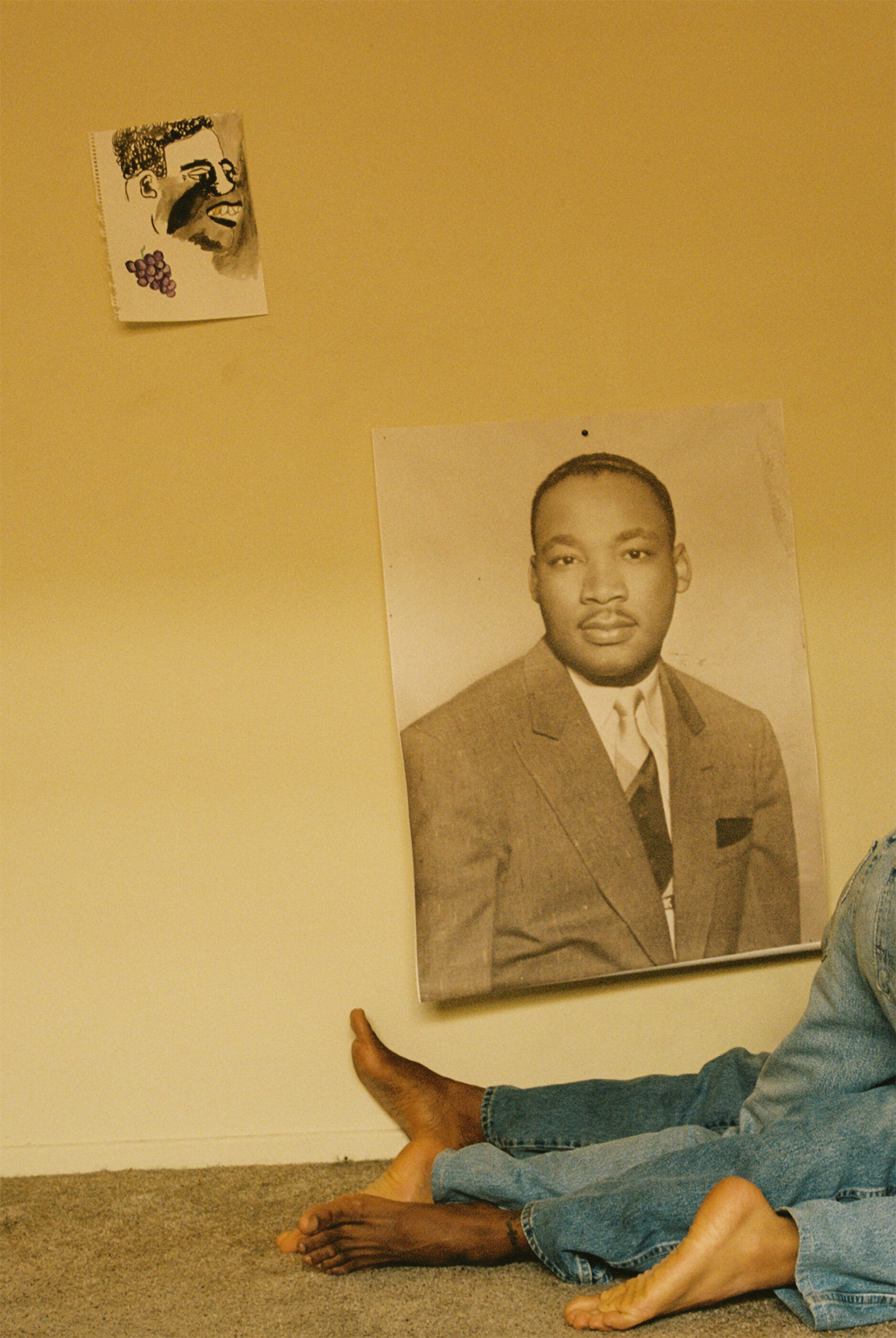
When did you realize that you were good at photography?
Oh, I don’t know. That’s such a funny question, because I think that kind of feeds into my moments with imposter syndrome, where I’m questioning everything. I feel like I can be good today, bad tomorrow, and good the next day. Good fluctuates.
Think about it, though. As an artist and in life, good and bad days always come, but overall, you’re still making forward progress.
Okay, in that case, I’ll be funny and say I knew I was good when I was around 17.
What were you making back then?
I was just taking pictures of like the desert and the forests in upstate Arizona. I remember getting my first favorite roll of film back when I went to the mountains with my family for Easter. All I did was take walks by creeks, cliffs, and take photos, but they turned out really beautiful. They were these milky, soft, images. Think I have them somewhere, like, on my first Tumblr.
Thinking about your growth as an artist and how your work has evolved, I wondered if it aligned with your personal maturation process.
Taking a look at your earlier work, I think a lot of what I see is a little bit more abstract, you use a lot of shapes to frame your subjects. The environments are usually an isolated landscape that maybe only these two people know exist, so they visit that place to embrace and to care for each other. It almost feels like the subjects are exploring new ideas and aren’t sure if what they’re doing is okay.
Progressing to your more intimate series of work, all of the settings are interior. If I’m putting my own story together, it seems like your subjects are maturing in their relationship. They’re more sure of who they are with each other, spending a lot of time together, embracing, and being romantic in each other’s homes.
All that to say, is that progression of your work parallel to your personal journey?
Wow. Absolutely. I mean, I don’t think it’s intentional, but it naturally happened that way. The earlier work you’re talking about is more about being alone in public, privately.
I remember when I was younger, gay or not, you would often go to the park to see the person you had a crush on. You were in these public spaces, but try to be as private in those spaces as possible.
Mm-hmm.
Because, at home, you don’t want to be teased by your siblings or want your parents to find out. And looking at like newer work you mentioned—well, it’s not as new anymore—you can see the curtains being pulled back a little more, because I’m not in the first stages of discovery anymore, I’ve progressed to a different stage in that journey.
Yeah, that’s kind of what I was getting at. Thanks for that. Now that you’re entering your 30s, I imagine we’re going to see an entirely new body of work, like you described with your exterior shots. Any idea what those photos will look like?
Now that I’m in New York, it’s discovery time, again. I’m going on a lot more walks now. I’ve always had ideas of people being couple-y in a bodega. Or I think about taking a medium format kind of shot where someone’s inside, then there’s a couple leaning against the wall outside, and then there’s maybe a woman passing by in heels. I’m ready to create more scenes that feel really nice. I’m trying to make my everyday surroundings reflect what my work looks like. Everywhere can be a photograph.
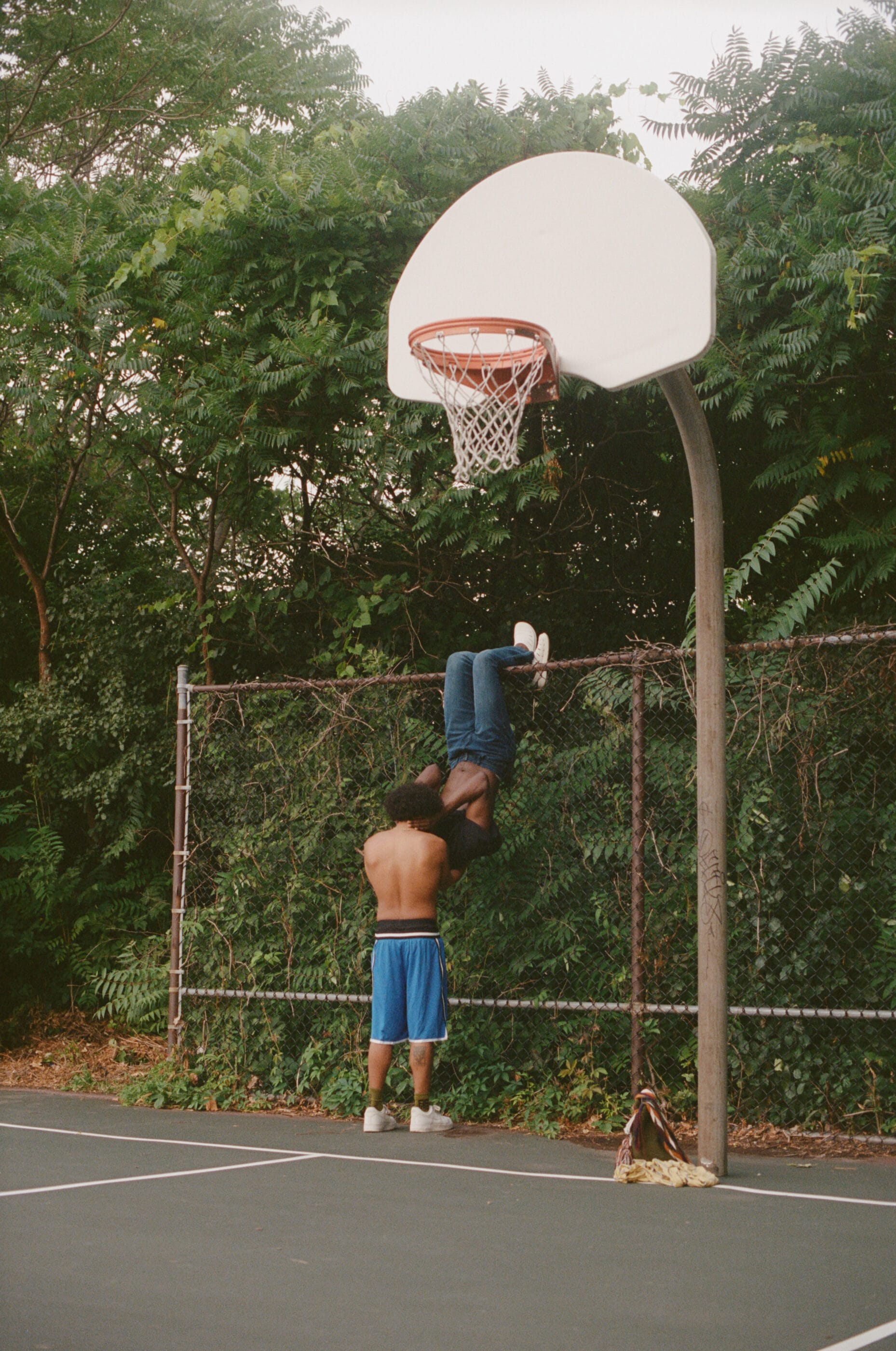

I’ve seen you talk in other interviews about being HIV positive, you’ve even made some projects about it. I didn’t think we needed to spend too much time on it, but how has publicizing that impacted your work?
You know how people like to make jokes about something serious? That’s kind of how I’ve approached it. I’ve just really dismantled the stigma behind it. Now, I kind of see it as a blessing. I think about queer ancestors. You know, so many artists in the past have been lost to HIV, and so it’s interesting that myself and so many other HIV-positive Black artists are alive and thriving now, almost as this homage to what they went through.
It feels like somewhat of a rite of passage in a way. So, I’m trying to look at it in that way and don’t let anything affect me in that regard.
That’s smart. The stigma around it was so heavy, that people felt like their lives ended in that moment. It’s not that way anymore.
Yeah, and I think the more people that speak on it, the more it just becomes normalized. Be safe, responsible, and take care of yourself first, but, you know, the more that I’ve been outspoken about it, the more that people come to me sharing a positive experience, whether about their own HIV status or in support of me and others who might be positive.
That’s great! Sometimes I notice that people can get pigeonholed and their whole identity is about that one thing they are, make, or carry. I don’t know if you feel this way…
Mm-hmm. That happens a lot. Just let me be an artist, and that’s the focus. Sure, you want to be vocal about these things to break the stigma and find community, but you don’t want those attributes to be a crutch. I sprinkle that information in my work. All the details about me are there if you want to find them.
Yeah, your approach is simple and poetic. Those are all of the questions I had. Thanks, Clifford! I appreciated that.
It was really nice talking with you. Thanks!
